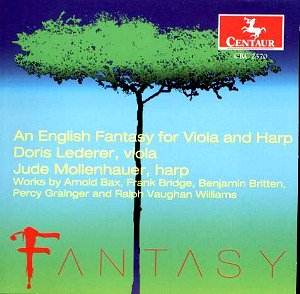AVAILABILITY
www.centaurrecords.com
Distributed by D I Music (UK) T: +44 (0)161
491 6655 F: +44 (0)161 491 6688 dimus@aol.com
Centaur’s programme note writer Steve Lubin is
right to draw attention to the role of Lionel Tertis in commissioning
new works for viola from British composers. Of course Tertis’s
influence was massive, long lasting and rather magnificent, a
few repertoire blips aside, and the Tertis-Richardson viola was
itself a living embodiment of his aesthetic, tonal and expressive
arch-Romanticism in its most practical form. But Tertis was not
alone and this disc surely also celebrates, at least in part but
certainly not by name – he’s not mentioned – a very different
violist. When I think of Bax and the viola I as often think of
Raymond Jeremy as I do of Tertis. The survival of the composer’s
own recording of the Viola Sonata with Tertis (on Pearl) has rather
overshadowed the Welsh-born friend of Edward Thomas. It was Jeremy
who first performed Bax’s Fantasy Sonata, and he played in the
premieres of the Sextet In Memoriam, the first Quartet,
the Harp Quintet and the one movement Quintet – spanning the years
1917 – 1935. As a member of the Philharmonic Quartet he was well
equipped to take on Bax’s chamber works in the context or continuum
of the Cobbett-inspired outpouring of chamber music. Thus he and
Maria Korchinska gave the premiere of the Fantasy Sonata in 1927
and recorded the first movement very shortly afterwards for Compton
Mackenzie’s National Gramophonic Society. There have been numerous
recordings since: Watson Forbes/Korchinska, in her second recording,
this time complete, Milton Thomas/Susann McDonald (a splendid
harpist who also recorded with, inter alia, Louis Kaufman), Vardi
and Ross, Ponder and Barford, Golani and Loman, Toutain and Perrin,
Thompson and Hobson and doubtless others. There is however a real
authority to Jeremy’s playing that is compelling and the authority
extends to matters of pacing and tempo relation. Doris Lederer
and Jude Mollenhauer are deeply poetic and sensitive interpreters;
Lederer has depth of tone in the lower two strings, well equalized
and an estimable rapport with harpist Mollenhauer. They bring
to the Bax a considered and frequently memorable if languid romanticism.
And yet turn to Raymond Jeremy in that all important opening movement
and we find a different kind of conception. It’s not simply the
sound Jeremy makes – old fashioned, late nineteenth century, sparing
of vibrato, quite different form Tertis and stretched a bit by
Bax’s technical demands – so much as his sense of dramatic movement
and flux. By comparison pretty much everyone else sounds becalmed.
He is intensely lyrical but also intensely dramatic. He is dynamic,
full of light and shade and even where he is fallible (some shifts
especially) he even then, almost by default, conveys colouristic
potential as well. The elliptical middle section of the first
movement for the harp emerges with Korchinska full of glint and
depth, Jeremy’s dynamics acutely mirroring the emotive flux of
the movement. Of course the special authority of a first performer
and recording is a tempting one; the work can withstand different
kinds of interpretation. Yet for me the ones that work best are
the ones that move.
My problem with the Lederer-Mollenhauer interpretation
is one of tempo uniformity. There are three Allegros here – molto,
moderato and a plain concluding Allegro. I find insufficient contrast,
for all their skill and affection. The first movement doesn’t
convince me and in the finale I began to chafe in the way I often
do with Bax. I admired the simplicity and technical assurance
of the performers but didn’t feel they had got to the core of
the work or managed to convey its inherent dynamism.
The rest of the programme has many a pleasure
though without much intellectual muscle. The arrangements of the
Bridge are all the better for Lederer not bathing her viola in
a vapour of vibrato. She is affectionately restrained in the Berceuse
and most attractive in the repetitious Serenade. Of the Vaughan
Williams selection the most impressively performed is the Andante
sostenuto – which is eloquence itself. Nothing will quite convince
me that Britten’s setting of Oliver Cromwell in this arrangement
for viola and harp will ever work – still it’s nice to hear it
once. But once is enough. They end with Grainger’s The Sussex
Mummers’ Christmas Carol – shades of Watson Forbes again in this.
The Bax Fantasy Sonata is clearly the ballast
here, the others arrangements and relatively lightweight at that.
It makes for an attractive programme, excellently produced with
commensurately good sound quality from the Centaur team.
Jonathan Woolf

